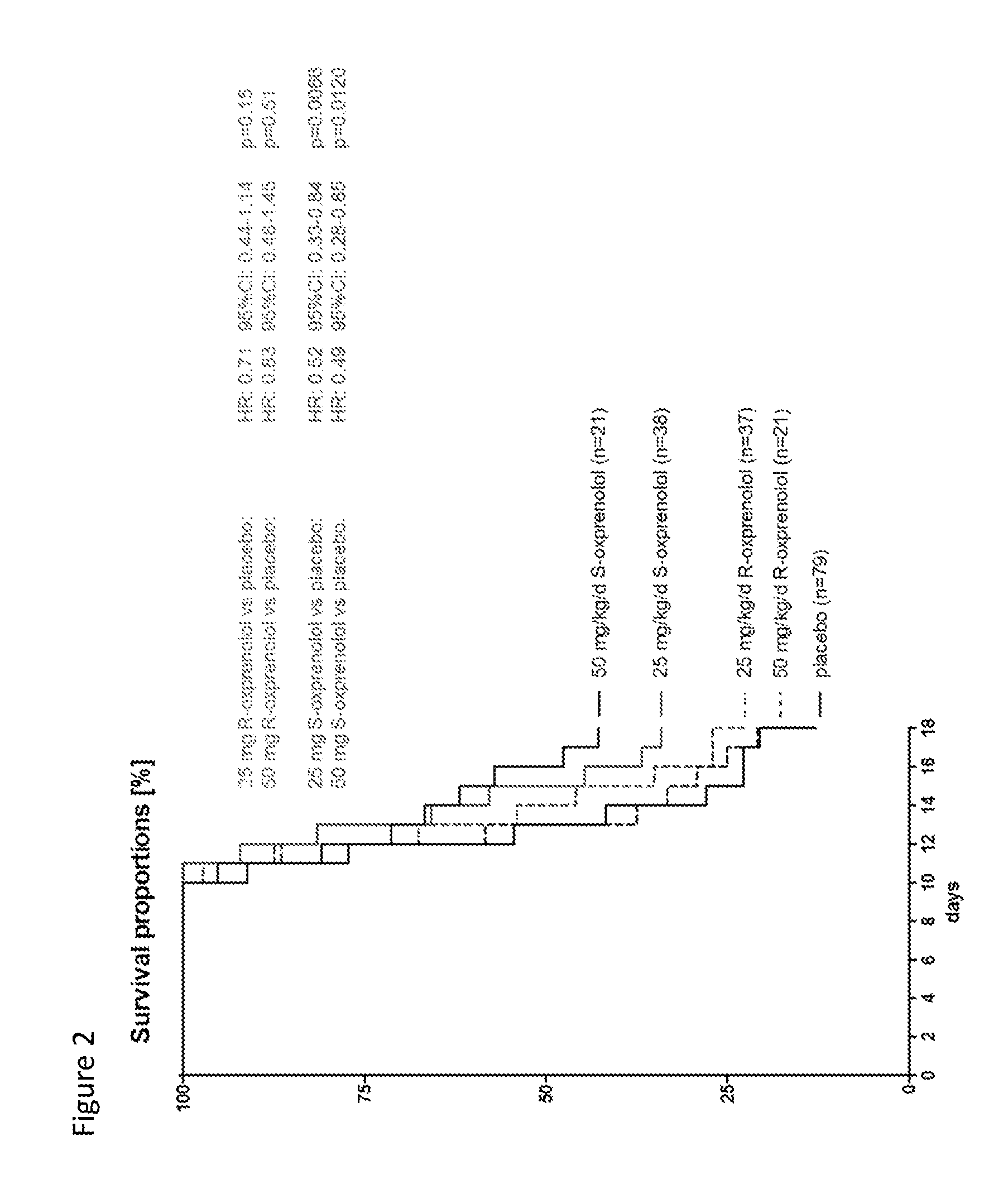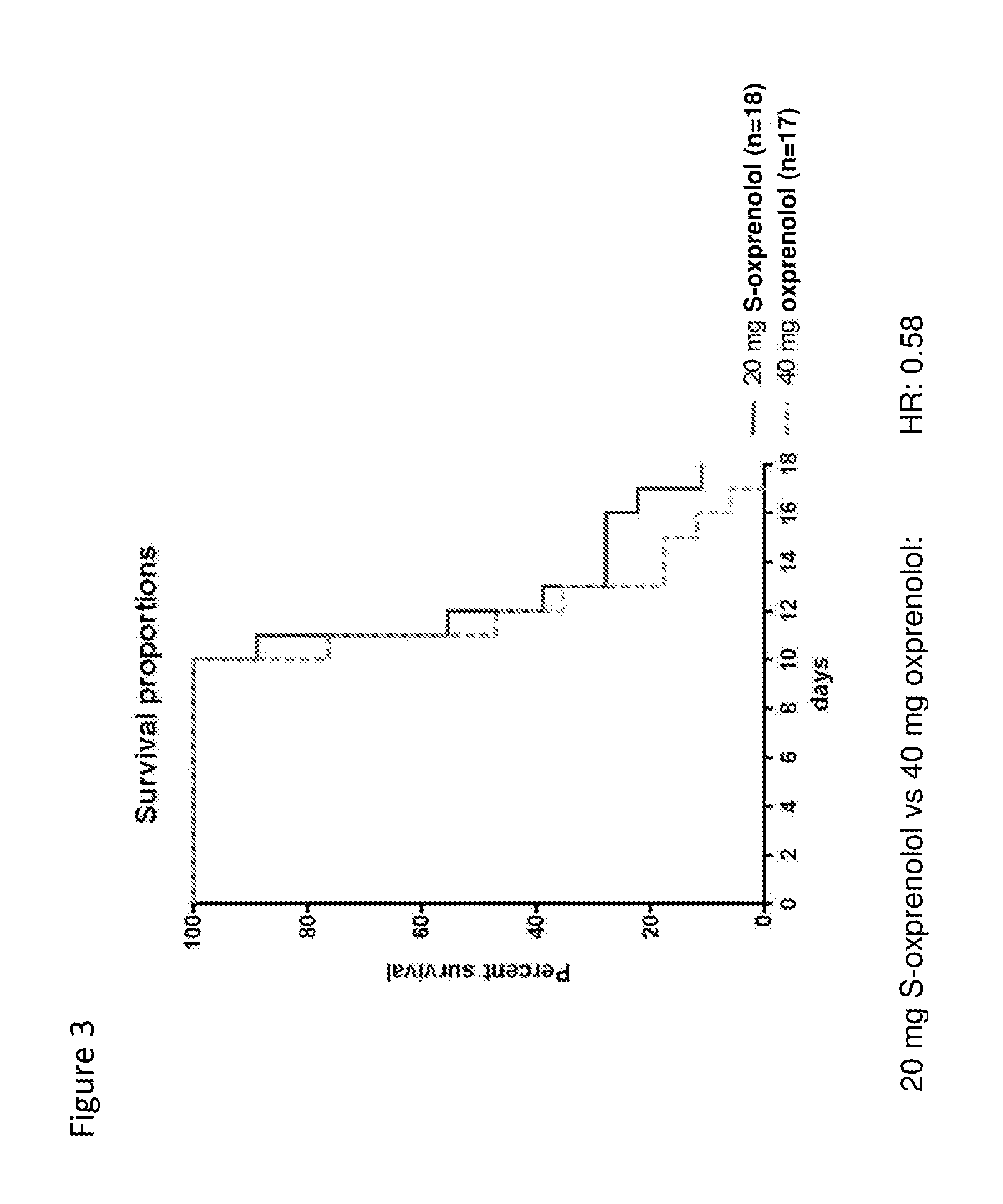Oxprenolol compositions for treating cancer
a technology of oxprenolol and compositions, which is applied in the direction of drug compositions, biocide, muscular disorders, etc., can solve the problems of inability to improve patient survival and limited effectiveness of most chemotherapeutic agents, so as to prolong the survival of an individual, improve quality of life, and prevent body weight loss
- Summary
- Abstract
- Description
- Claims
- Application Information
AI Technical Summary
Benefits of technology
Problems solved by technology
Method used
Image
Examples
example 1
Synthesis of S-Oxprenolol
[0160]The synthesis of S-oxprenolol is shown in Scheme 1.
Preparation of 2-(allyloxy)phenol
[0161]To a solution of catechol (1) (40.0 g, 0.364 mol) in acetone (160 mL) was added potassium carbonate (50.0 g, 0.363 mol) portion-wise at room temperature, over a period of 30 minutes. After the addition was complete the mixture was stirred at room temperature for 1 hour. Allyl bromide (31.0 mL, 0.358 mol) was then added over a period of 30 minutes, and the reaction heated to 60-70° C. for 6 hours. The reaction was allowed to cool, then water and ethyl acetate were added and the mixture was separated. The organic layer was dried (MgSO4) and the solvent evaporated to give 2-(allyloxy)phenol, (2) (46.2 g) as a 7:3 mixture of mono and bis alkylated material.
[0162]1H NMR (300 MHz, CDCl3) δ 6.93-6.77 (m, 4H), 6.05 (m, 1H), 5.41 (dd, 1H), 5.30 (m, 1H), 4.61 (d, 2H). LCMS: Rt 0.70 min, [M+H]+ 148.9, 70%.
Preparation of S-Oxprenolol
[0163]CsF (22.8 g, 0.150 mol) was added to ...
example 2
Synthesis of R-Oxprenolol
[0166]The synthesis of S-oxprenolol is shown in Scheme 2.
Preparation of R-Oxprenolol
[0167]CsF (2.95 g, 19.4 mmol) and K2CO3 (17.3 g, 125 mmol) were added to a solution of 2-(allyloxy)phenol (14.4 g, 96.2 mmol) in DMF (250 mL) and stirred for 30 minutes at room temperature. (R)-Glycidyl nosylate (25.0 g, 96.4 mmol) was added and the reaction stirred for 48 hours at room temperature. iPrNH2 (190 mL, 2.21 mol) was added in one portion and the reaction stirred for 72 hours. The reaction mixture was diluted with water (1.0 L) and extracted with EtOAc (3×300 mL). The combined organics were washed with HCl (2.0 M, 3×300 mL). The aqueous layer was pH adjusted to pH 12 with NaOH (2.0 M) and extracted into EtOAc (2×500 mL). This was washed with 1:1 water / brine (3×500 mL), then with brine (500 mL), dried over Na2SO4 and concentrated. The crude solid was triturated from heptanes, filtered and dried under vacuum at 40° C. overnight to give (R)-oxprenolol (24.5 g, 69%) as...
example 3
Study Protocol with Yoshida Hepatoma Model
[0170]Ascites hepatoma Yoshida AH-130 cells (108 cells) were inoculated into about 200 gram male Wistar rats by i.p. injection. Alternatively animals received saline injection only (sham). The day after inoculation animals were randomized into various groups and then received twice daily treatment with either placebo or various test compositions by oral gavage over a period of up to 17 days. The primary endpoints of the study included assessment of body weight, body composition (with and without tumor), and survival. Body composition was monitored by NMR. Echocardiography was used in instances to monitor condition of the heart. Organ weight was assessed at the end of the study (or after death) as a secondary endpoint. In addition, locomotor activity and food intake were also assessed. FIG. 1 provides a diagram showing the design study. R- and S-oxprenolol were manufactured to order by Peakdale Molecular, Peakdale Science Park, Sheffield Road...
PUM
| Property | Measurement | Unit |
|---|---|---|
| enantiomeric excess | aaaaa | aaaaa |
| enantiomeric excess | aaaaa | aaaaa |
| enantiomeric excess | aaaaa | aaaaa |
Abstract
Description
Claims
Application Information
 Login to View More
Login to View More - R&D Engineer
- R&D Manager
- IP Professional
- Industry Leading Data Capabilities
- Powerful AI technology
- Patent DNA Extraction
Browse by: Latest US Patents, China's latest patents, Technical Efficacy Thesaurus, Application Domain, Technology Topic, Popular Technical Reports.
© 2024 PatSnap. All rights reserved.Legal|Privacy policy|Modern Slavery Act Transparency Statement|Sitemap|About US| Contact US: help@patsnap.com










